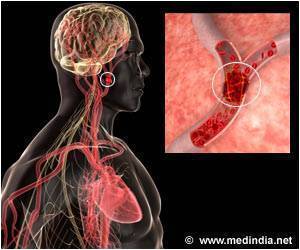At Johns Hopkins, researchers report that hospitalized patients do not receive more than one in 10 doses of doctor-ordered blood thinners prescribed to prevent potentially lethal or disabling blood clots.

Calling the rate of missed doses "unacceptably high," the researchers add that hospitalized patients are at a significantly greater risk of developing venous thromboembolism, or VTE, and that preventive blood thinners can prevent it a majority of the time.
"There appeared to be a lack of understanding about the risks and benefits of blood thinners among patients and medical staff, even though the research is clear that blood thinners are very effective at preventing blood clots," says Kenneth M. Shermock, Pharm.D., Ph.D., the director of the Center for Medication Quality and Outcomes at The Johns Hopkins Hospital, and leader of the study published in the journal PLOS ONE. "Blood clots and their resulting effects are the most common cause of avoidable death for hospitalized patients and we've got a medication that can prevent most of these events. But too many patients are not benefitting."
Shermock and his colleagues say their study found that 12 percent of ordered doses were not administered to patients, with the most commonly documented reason being patient or family-member refusal (59 percent). Patients were sometimes off the floor getting tests or in surgery when the doses are scheduled to be given.
Other research done by Shermock suggests that in some cases nursing staff may have implied to patients that blood thinners are optional. Shermock says it is important to understand the reasons behind this finding and provide more education emphasizing the proven benefits of blood thinners for hospitalized patients.
For the PLOS ONE study, Shermock and his colleagues analyzed more than 103,000 VTE prophylaxis doses of unfractionated heparin or enoxaparin ordered for more than 10,500 patients at The Johns Hopkins Hospital between Dec. 1, 2007 and June 30, 2008. Patients from 29 floors were included in the analysis: 11 medicine floors, nine surgery floors, four neurology floors and five intensive care units. They found that while 12 percent of the time ordered doses of blood thinner were not given to the patients, some floors of the hospital had much lower compliance rates.
Advertisement
Shermock says that, overall, a majority of patients get most of their prescribed doses, which are given at eight-, 12- or 24-hour intervals. Nearly 60 percent of patients received all of their ordered doses. Roughly 20 percent of patients accounted for 80 percent of missed doses, with 20 percent of patients missing at least a quarter of their doses and 10 percent missing more than half of their doses, he says.
Advertisement
In addition to gaining unique insight on the nature of the problem, the Johns Hopkins team appears to be out in front in terms of solutions. Since learning about the data from the study, the Johns Hopkins multidisciplinary Venous Thromboembolism Prevention Collaborative has conducted studies looking at provider and patient factors associated with non-administered doses of VTE prophylaxis. The committee has also learned from nurses, for example, that some patients refused prophylaxis because of the pain and bruising associated with the shots, so a pilot program has been started to test a new method of injection that is less painful.
Meanwhile, a research team led by Elliott R. Haut, M.D., intends to continue this new line of research thanks to a three-year $1.5 million contract from the Patient-Centered Outcomes Research Institute (PCORI), an independent, nonprofit organization authorized by Congress to fund research that will provide patients, their caregivers and clinicians with the evidence-based information needed to make better-informed health care decisions. The contract, entitled "Preventing Venous Thromboembolism: Empowering Patients and Enabling Patient-Centered Care via Health Information Technology," will allow the group to more effectively target and intervene in instances where blood thinners are not being provided, and work with patients, nurses and other members of the health care team to come up with better ways to provide effective VTE prophylaxis.
Michael B. Streiff, M.D., the study's senior author and an associate professor of medicine and pathology in the Division of Hematology, says there remains some discussion about whether all patients on medical floors need prophylactic blood thinners, because some may be at very low risk of developing blood clots. That being said, Streiff points out that we do not yet have a well-validated tool to identify which patients do not need prophylaxis.
"The nurses may be exactly right that some of the patients don't need blood thinners," he says, "but more research is needed."
Source-Eurekalert















